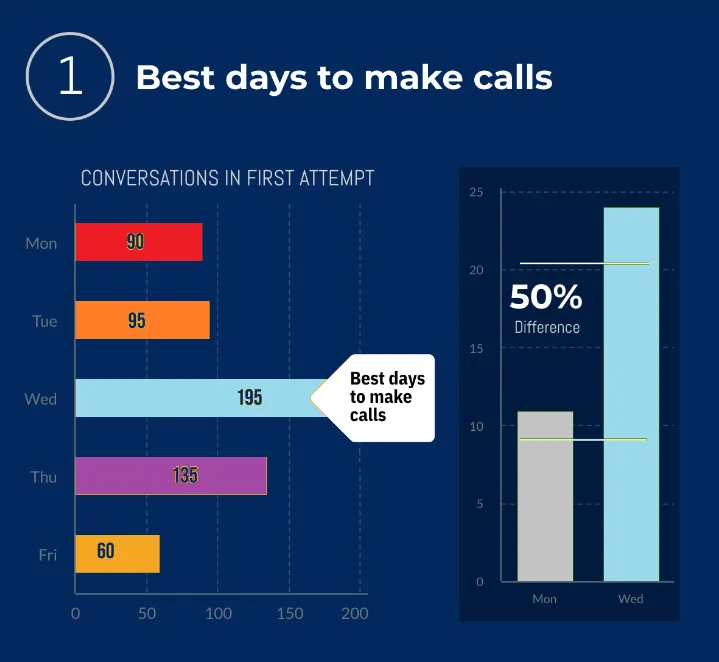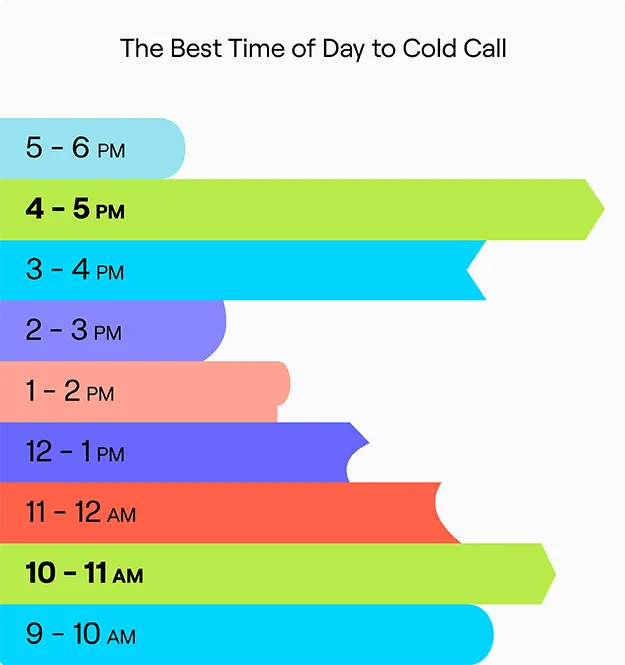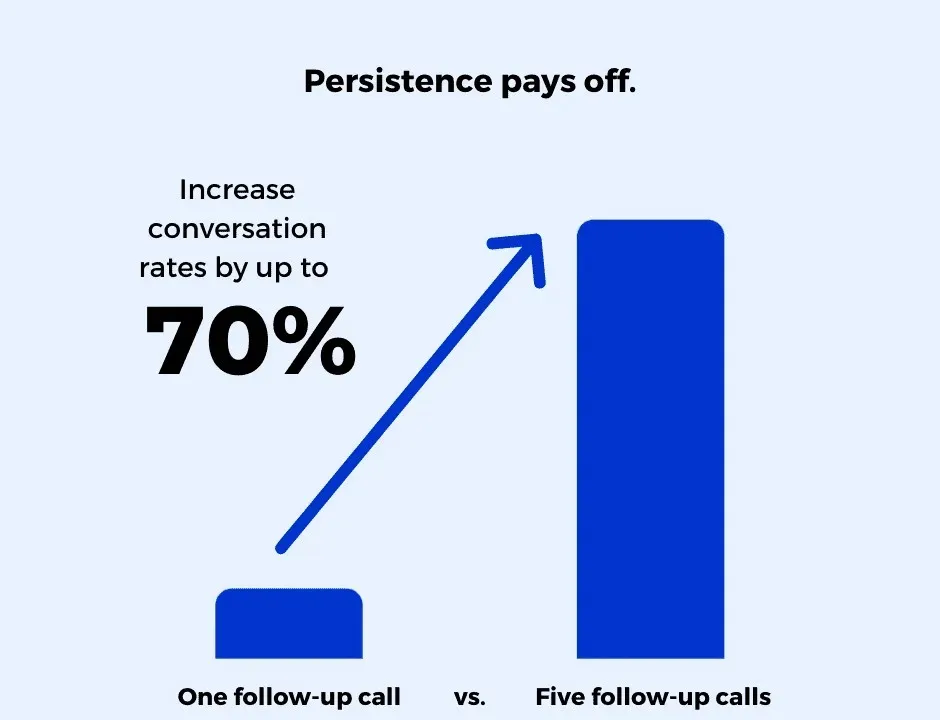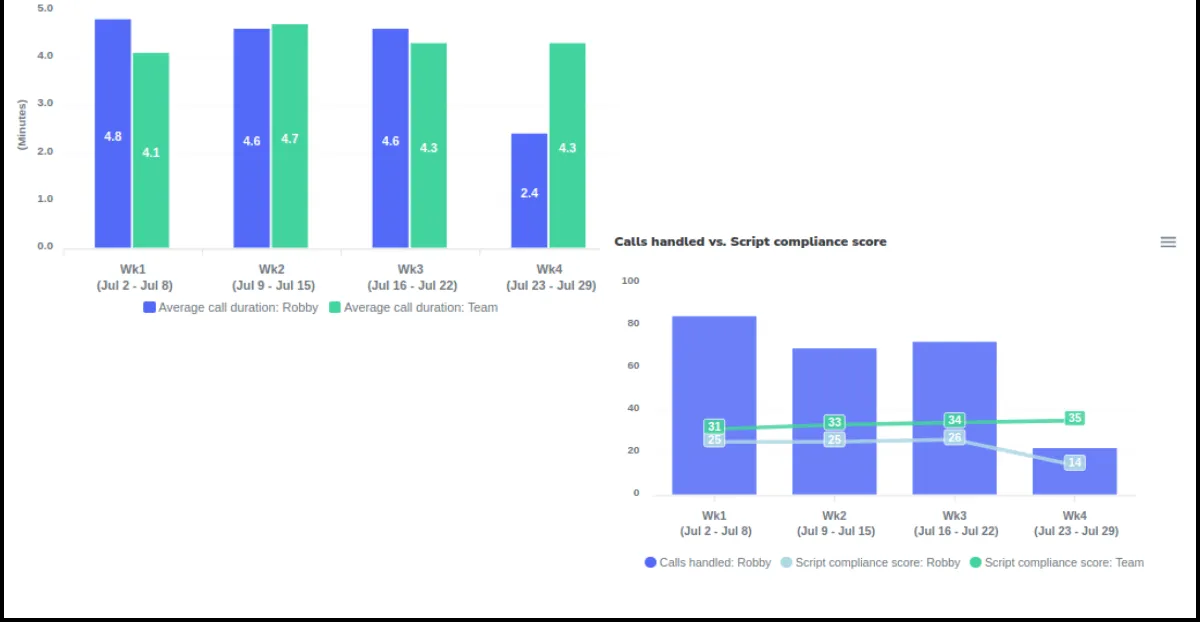Best Time for Cold Calling to Maximize Impact

Cold calling remains a fundamental strategy in sales, primarily because it allows direct interaction with potential clients. Effective cold calling can significantly increase lead generation and sales conversions, but its success heavily depends on timing.
Calling at the right moment increases the likelihood of engaging a prospect and can dramatically improve the outcomes of these calls.
To maximize the impact of cold calling, a structured approach to timing is essential. By aligning your calling schedule with the habits and preferences of your target audience, choosing the most responsive days of the week, and identifying peak times of day, you can significantly enhance the effectiveness of your sales efforts. Let's break down these components:
1. Understanding the Target Audience
Knowing your target audience is the foundation of effective cold calling. Tailoring your approach based on the specific demographics, industry practices, and daily routines of your prospects ensures that your calls are timely and relevant.
- Demographic Analysis: Assess the age, role, and industry of your potential clients. For instance, decision-makers in executive roles are often more available in the early mornings or late afternoons.
- Industry-Specific Schedules: Different industries have distinct active hours. For example, real estate agents might be more accessible in the early evening, while IT professionals might be more available in the late morning.
- Time Zone Considerations: Be mindful of the geographical distribution of your target audience. Calling someone at 9 AM your time might mean calling another at 6 AM.
By analyzing CRM data and previous call logs, identify patterns that suggest when prospects are most likely to answer and engage. Use this data to refine your call timing.
2. Optimal Days of the Week

Selecting the right days to make cold calls can significantly affect the outcomes. Studies and sales data generally point towards the middle of the week as the most effective time to reach out.
- Mid-Week Efficiency: Wednesday and Thursday are universally recognized as the best days to cold call. Data shows that contact rates and positive response rates peak during these days.
- Avoid Mondays and Fridays: These days typically have lower engagement rates. Mondays are catch-up days, and Fridays are winding-down days in most professional settings.
Track response rates by day using a simple A/B testing approach over several weeks. Adjust your calling schedule based on the results to focus on days with higher success rates.
3. Best Times of Day

Identifying the best times of day to call is crucial. This timing is generally influenced by common workday patterns and individual availability.
- Late Morning Calls (10 AM to 12 PM): After the morning rush, professionals are more likely to have free time to engage in a call.
- Late Afternoon (4 PM to 6 PM): As the day winds down, people may be more open to new opportunities before they leave the office.
Use call tracking software to monitor when your calls are most likely to be answered and lead to longer conversations. Implement this intelligence to target your calls during these optimal windows.
Avoid Cold Calling in lunch hours:
- Besides being a common lunch break time, this period also sees a drop in professional activity as people often use this time for personal errands or rest.
- Studies show a significant dip in engagement rates during these hours, with some industries reporting more than a 10% drop in response rates.
- Avoid scheduling calls during these hours. Instead, analyze the responses from earlier calls and plan adjustments for future strategies.
Late Afternoon on Fridays (after 4 PM):
- The weekend is starting for many, and the likelihood of engaging in business discussions drops significantly.
- Shift your focus to administrative tasks or setting up your schedule for the following week.
4. Adjust Based on Feedback and Data of Cold Calls
Continuous improvement is key to refining cold calling strategies. Leveraging feedback and data not only fine-tunes the process but also ensures adaptation to changing dynamics and preferences.
- Collect and Analyze Call Data: Utilize call analytics tools to track success rates, call durations, and feedback from calls. Monitor metrics like conversion rates and customer engagement.
- Iterative Process: Use A/B testing for different times and days to see which yield better results. Be ready to shift strategies based on what the data shows.
- Feedback Loops: Encourage sales reps to gather direct feedback from prospects on call timing and their receptiveness. Integrate this feedback into planning and training sessions.
5. Consider Seasonal and Cultural Factors for Sales Calls
Seasonal changes and cultural nuances can greatly impact the success rate of cold calling. Being aware of these factors and planning accordingly can prevent potential faux pas and optimize timing.
- Recognize Public Holidays and Vacation Periods: Avoid major holidays or vacation seasons when people are less likely to be in the office or focused on business.
- Cultural Considerations: Understand and respect regional and cultural differences, such as significant local events or non-working days in specific markets.
- Seasonal Sales Opportunities: Align calls with industry-specific busy periods or seasons when your product might be in higher demand.
Tailoring your cold calling schedule to consider these factors can help avoid wasted efforts and increase receptiveness. This approach not only shows respect for your prospects' time but also aligns your calls with the most opportune moments for engagement.
6. Leverage Technology and Automation
Technology can significantly streamline the cold calling process, making it more effective and less intrusive for both the caller and the recipient.
- CRM Integration: Use Customer Relationship Management (CRM) tools to schedule calls and log details about interactions, preferences, and outcomes.
- Automated Dialers: Implement auto-dialers to increase call volume and reduce idle time between calls. Ensure compliance with regulations to avoid penalties.
- Analytics and AI: Deploy analytics software and AI to predict the best times to call based on historical data and propensity models.
By integrating advanced technologies, you can optimize call schedules, personalize calls based on prospect information, and ultimately increase the success rates of your cold calling campaigns.
This not only enhances productivity but also improves the overall experience for both parties involved.
Best Cold Calling Times for Key Industries
8 Cold Calling Tips and Strategies for Sales Success

To maximize the impact of cold calling, particularly when aligned with the best times to reach out, understanding the nuances of response management, the value of persistence, and the effective use of scripts is essential. Here are 9 focused strategies:
1. Optimizing Response Timing for Peak Engagement
The timing of your follow-up after initial contact can dramatically influence the outcome of your cold calling efforts.
- Immediate Follow-Ups: Responding swiftly to any initial contact or inquiry can significantly increase your chances of conversion. Studies suggest that a follow-up within an hour of contact can improve conversion rates by over 7 times compared to waiting even a day.
- Utilize CRM for Timely Responses: Employ CRM tools to track when messages are received and ensure timely responses, especially during the best time to make cold calls.
Quick response times demonstrate to potential clients that you value their interest and time, thereby increasing their engagement and willingness to listen.
This practice is particularly effective when combined with insights from response time analytics to optimize interaction times.
2. Persistence as a Key to Cold Calling Success

Regular follow-ups are crucial in cold calling, as persistence often leads to higher success rates.
- Strategic Follow-Up Calls: Schedule follow-up calls at different times and days (considering optimal cold call hours) to increase the likelihood of reaching your prospect.
- Data-Driven Persistence: Use data from previous interactions to determine the best times for follow-ups. Persistence should be informed and strategic rather than random.
Persistence shows the prospect that you are genuinely interested in doing business with them.
It often takes multiple contacts before a prospect is ready to engage seriously, highlighting the importance of a persistent yet respectful approach.
3. Leveraging Scripts to Enhance Conversion Rates

Well-crafted scripts tailored to different stages of the customer journey can greatly improve the effectiveness of cold calls.
- Scripted Introductions and Closings: Develop scripts that include a strong opening to grab attention and a compelling close that encourages further action, aligning these scripts with the best time to cold call to maximize impact.
- Customization Based on Prospect Data: Adapt scripts based on the information known about the prospect or their industry, which can be gathered through CRM insights.
Scripts help standardize communication and ensure that key points are consistently conveyed.
They also provide a safety net for less experienced callers, ensuring that every call maintains a professional standard.
4. Utilize Call Analytics to Refine Strategies

In-depth analysis of your call outcomes can provide invaluable insights, allowing for targeted improvements in your approach and timing.
- Analyze Call Performance Data: Use analytics to monitor the performance of calls made at different times of day and week. This can help identify patterns in when prospects are most receptive.
- Adjust Call Times Based on Insights: Tailor your calling schedule based on data-driven insights to increase the likelihood of successful outcomes. For example, if analytics suggest that calls made on Wednesday afternoons yield higher success rates, prioritize calling during these windows.
Employing call analytics ensures that your strategy is continuously evolving and improving based on actual performance data. This approach allows you to dynamically adjust your tactics, focusing on what truly works best.
5. Enhance Caller Training with Role-Playing
Simulated interactions can dramatically improve the preparedness and confidence of your sales team, which is crucial for effective cold calling.
- Regular Role-Playing Sessions: Conduct frequent training sessions where sales reps can practice cold calls with different scenarios and prospect objections.
- Feedback and Improvement: Use these sessions to provide constructive feedback, allowing reps to refine their approach and better handle real-life situations.
Role-playing helps to build skills in a controlled environment, reducing the learning curve in actual sales situations.
This preparation is particularly beneficial when aligned with the best times to cold call, as it ensures that your team performs optimally when it matters most.
6. Integrate Multi-Channel Follow-Up Strategies

Combining cold calling with other communication channels can enhance overall engagement and increase the chances of converting prospects into clients.
- Follow-Up with Emails and Social Media: After an initial call, reinforce your message and maintain visibility by following up through emails or LinkedIn messages, especially if calls do not immediately convert.
- Leverage Automated Tools: Use tools to schedule and automate these follow-ups, ensuring they occur at strategic times based on earlier interactions and preferred contact times.
Multi-channel follow-ups provide multiple touchpoints for engagement, accommodating different communication preferences among prospects.
7. Prioritize Personalization in Every Call
Personalization goes beyond using the prospect’s name; it involves tailoring the conversation to meet the specific needs and interests of the individual or their business.
- Gather Detailed Prospect Information: Before calling, research the prospect’s business, recent news, challenges, and industry trends. Use LinkedIn, company websites, and press releases for the most current information.
- Customize Your Pitch: Tailor your pitch to address the specific challenges or opportunities identified during your research. Highlight how your product or service provides a solution tailored to their needs.
Personalization shows that you respect the prospect’s time and business, which can significantly increase their interest and willingness to engage.
8. Develop a Strong Call Opening Strategy
The first few seconds of a call can determine its success. Crafting a compelling opening is critical to capture and retain the prospect’s attention immediately.
- Use a Strong Opening Statement: Begin with a concise and powerful statement that clearly articulates the value you’re offering, ideally connecting directly to a known need or pain point.
- Practice and Perfect the Delivery: Train your sales team to deliver this opening with confidence. Use tone and pacing effectively to engage the listener right from the start.
A strong opening ensures the prospect understands the purpose of the call quickly and how listening further could be beneficial for them. This strategy is most effective during the best times to cold call when the prospect is most likely to be receptive.
When to Cold Call in B2B vs B2C Settings
How to Win the Call When You Called at Both Right and Wrong Time
Winning a cold call, whether you've dialed at the right or wrong time, hinges on your ability to quickly adapt to the situation, gauge the prospect's receptiveness, and effectively communicate the value of your offering.
Here’s a strategic guide on how to manage both scenarios to increase your chances of a successful cold call:
1. Identify and Adapt to the Prospect's Tone and Mood
Right Time: If you’ve called at a seemingly right time and the prospect answers enthusiastically, capitalize on this by moving swiftly into your pitch. This is just what most sales reps hope for—a receptive audience. Be concise and focus on how your solution can specifically benefit them based on your prior research.
Wrong Time: If the timing feels off, perhaps due to the prospect sounding rushed or irritated, acknowledge their situation. Ask if they prefer a different time for a call-back, demonstrating respect for their time. This can leave a positive impression, making them more likely to engage with you later.
2. Quickly Establish Credibility
Right Time: Leverage the momentum by quickly establishing your credibility during the phone calls. Mention any mutual connections, reference past successes, or note any endorsements from known entities within their industry.
Wrong Time: Even in less-than-ideal timing, aim to leave a nugget of information that establishes your credibility or piques their interest, making them more receptive to a future conversation.
3. Engage with Relevant and Concise Messaging
Right Time: Since you’ve caught them at a good moment, use this opportunity to delve into how your product or service solves a problem they might be facing. Use data and specific examples to strengthen your case in what could become a key sales call.
Wrong Time: Keep your message brief and focused. Quickly articulate a key benefit or ask a probing question that might resonate with their business needs, which could shift the conversation’s tone to something more constructive.
4. Provide Immediate Value
Right Time: Offering something of immediate value, such as a free trial, a relevant white paper, or an invitation to a webinar, can capitalize on the positive reception of your call. These are effective sales strategies that add value and show understanding of the customer’s needs.
Wrong Time: Suggest a quick tip or insight related to their industry challenges, even if the call does not continue. This positions you as a helpful resource rather than just another salesperson making cold call prospects.
5. Follow-Up Appropriately
Right Time: Send a follow-up email thanking them for their time, recapping your discussion, and outlining the next steps. This reinforces your professionalism and the key messages from your calling prospects.
Wrong Time: If the call was brief and at a bad time, your follow-up email should acknowledge the inconvenience, propose a better time for a discussion, and briefly state the potential value you could offer. This shows you are considerate and attentive to their needs.
Concluding Thoughts on the Best Time to Cold Call
In conclusion,understanding the best times to make sales calls in 2024 hinges on a strategic, data-driven approach that aligns with the specific habits of your target audience and broader industry trends. By meticulously analyzing optimal days and times for cold calling, you can significantly enhance engagement and conversion rates.
This involves tailoring your cold calling schedule to match the daily rhythms and availability of your prospects, thus not only increasing the effectiveness of each call but also cultivating a respectful and professional brand image.
Furthermore, continuously adapting to new data, feedback, and changing conditions is crucial for maintaining effectiveness in your cold calling strategies. Adhering to these guidelines will ensure that your cold calling efforts are both successful and efficient.







